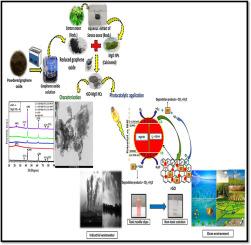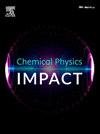Eco-friendly synthesis and photocatalytic application of rGO-MgO nanocomposites for eosin Y dye degradation
IF 4.3
Q2 CHEMISTRY, PHYSICAL
引用次数: 0
Abstract
Reduced graphene oxide-magnesium oxide nanocomposites (rGO-MgO NCs) were synthesized via a green and sustainable route using Saraca asoca leaf (Sa-leaf) extract as a natural reducing and capping agent. Graphene oxide, prepared using the modified Hummers method, was reduced and combined with MgO nanoparticles (MgO NPs) through a simple grinding technique. Structural and morphological characterizations confirmed the formation of a crystalline face-centered cubic MgO phase with nanorod and spherical morphologies uniformly distributed on rGO sheets. The nanocomposites exhibited an average particle size of 21.5 nm and a reduced band gap of 2.84 eV, enhancing charge separation and visible-light absorption. Under 500 W visible-light irradiation, the rGO-MgO NCs achieved 92.4% degradation of Eosin Y (EY) dye, following first-order kinetics, and demonstrated excellent stability and reusability across multiple cycles. Furthermore, ECOSAR-based toxicity predictions indicated that the degradation byproducts were environmentally benign. These findings highlight the potential of Sa-leaf-mediated rGO-MgO NCs as efficient, sustainable, and eco-friendly photocatalysts for wastewater remediation.

rGO-MgO纳米复合材料降解伊红Y染料的生态合成及光催化应用
采用绿色、可持续的方法,以刺叶提取物为天然还原剂和封盖剂,合成了还原性氧化石墨烯-氧化镁纳米复合材料(rGO-MgO NCs)。采用改进的Hummers方法制备氧化石墨烯,通过简单的研磨技术将其还原并与MgO纳米颗粒(MgO NPs)结合。结构和形态表征证实形成了面心立方MgO相,其纳米棒和球形形貌均匀分布在氧化石墨烯薄片上。纳米复合材料的平均粒径为21.5 nm,带隙减小到2.84 eV,增强了电荷分离和可见光吸收。在500 W可见光照射下,rGO-MgO纳米颗粒对伊红Y (EY)染料的降解达到92.4%,符合一级动力学,并表现出优异的稳定性和多次循环的可重复使用性。此外,基于ecosar的毒性预测表明,降解副产物对环境无害。这些发现强调了sa叶介导的rGO-MgO NCs作为废水修复中高效、可持续和环保的光催化剂的潜力。
本文章由计算机程序翻译,如有差异,请以英文原文为准。
求助全文
约1分钟内获得全文
求助全文
来源期刊

Chemical Physics Impact
Materials Science-Materials Science (miscellaneous)
CiteScore
2.60
自引率
0.00%
发文量
65
审稿时长
46 days
 求助内容:
求助内容: 应助结果提醒方式:
应助结果提醒方式:


